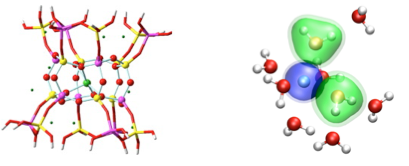Cation-rich aluminosilicates, which include clays and zeolites, are some of the principal minerals found on the Earth’s surface.1 Their abundance, coupled with their ability to act as retention barriers for heavy metals, explains their involvement in a number of environmental and industrial contexts.2 These minerals play a key role in the dissemination of toxic pollutants in the environment, especially near industrial sites, but also in current remediation strategies. In all these contexts, it is paramount that we acquire a better understanding and capacity to predict how charged, radioactive or toxic metals are transported through and sorbed by these nanoporous minerals.
Molecular modelling is widely recognized as an essential tool for this purpose, as it complements macroscopic experiments by allowing researchers to uncover and single out the microscopic mechanisms at play.3,4 Classical molecular simulations, which are required to compute the properties relevant to sorption, however, rely on an accurate description of interactions on the atomic scale. Such models are still lacking for heavy metals in contact with aluminosilicate surfaces. The aim of this project is to develop the microscopic models that will be used to predict the structural, thermodynamics and dynamics properties of heavy cationic species interacting covalently with functional groups found on the surface of nanoporous oxides. Theoretical predictions will be compared to experimental results obtained within a collaboration with the Laboratoire de Réactivité de Surface (UPMC, Paris).

Funding This grant is funded by the DIM-Oxymore Network on functional oxides (Région Ile-de-France)
Contact Anne Boutin (
This e-mail address is being protected from spambots. You need JavaScript enabled to view it
)
Laboratoire PASTEUR, Département de Chimie, Ecole Normale Supérieure, Paris www.chimie.ens.fr
Benjamin Rotenberg (
This e-mail address is being protected from spambots. You need JavaScript enabled to view it
)
Laboratoire PECSA, UPMC (Université Pierre et Marie Curie), Paris www.pecsa.upmc.fr
1. B. Rotenberg, A. J. Patel and D. Chandler, J. Am. Chem. Soc., 2011, 133, 20521.
2. V. Marry, B. Rotenberg and P. Turq, Phys. Chem. Chem. Phys., 2008, 10, 4802.
3. B. Rotenberg, V. Marry, R. Vuilleumier, N. Malikova, C. Simon and P. Turq, Geochim. Cosmochim. Acta, 2007, 71, 5089. 4. M. Jeffroy, A. Boutin and A.H. Fuchs, J. Phys. Chem. B, 2011, 115, 15059.




